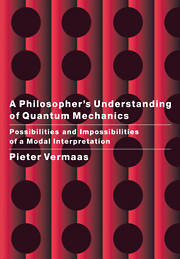 A Philosopher's Understanding of Quantum Mechanics
A Philosopher's Understanding of Quantum Mechanics Published online by Cambridge University Press: 28 October 2009
Before considering the particulars of the different versions of the modal interpretation in the next chapter, I first present their common characteristics. Then I list the starting points from which I develop these modal interpretations to fully-fledged descriptions of reality. Finally, I give the criteria I think interpretations should meet and present a number of desiderata I hope they meet.
General characteristics
The name ‘modal interpretation’ originates with Van Fraassen (1972) who, in order to interpret quantum mechanics, transposed the semantic analysis of modal logics to the analysis of quantum logic. The resulting interpretation was for obvious reasons called the modal interpretation of quantum logic. Since then, the term modal interpretation has acquired a much more general meaning and lost its direct kinship with modal logics. In particular new interpretations of quantum mechanics developed in the 1980s by Kochen (1985), Krips (1987), Dieks (1988), Healey (1989) and Bub (1992) became known as modal interpretations and also older traditions like Bohmian mechanics (Bohm 1952; Bohm and Hiley 1993) were identified as modal ones. But why are all these interpretations still called modal? And what is the present-day meaning of this term?
I think part of the answer to the first question has to do with public relations. The name ‘modal’ is short, sounds nice and is rather intriguing. Furthermore, I guess that also Van Fraassen's prestige as a philosopher of science adds a special gloss to the term. But, apart from all this, I believe the name ‘modal interpretation’ is quite suited.
To save this book to your Kindle, first ensure [email protected] is added to your Approved Personal Document E-mail List under your Personal Document Settings on the Manage Your Content and Devices page of your Amazon account. Then enter the ‘name’ part of your Kindle email address below. Find out more about saving to your Kindle.
Note you can select to save to either the @free.kindle.com or @kindle.com variations. ‘@free.kindle.com’ emails are free but can only be saved to your device when it is connected to wi-fi. ‘@kindle.com’ emails can be delivered even when you are not connected to wi-fi, but note that service fees apply.
Find out more about the Kindle Personal Document Service.
To save content items to your account, please confirm that you agree to abide by our usage policies. If this is the first time you use this feature, you will be asked to authorise Cambridge Core to connect with your account. Find out more about saving content to Dropbox.
To save content items to your account, please confirm that you agree to abide by our usage policies. If this is the first time you use this feature, you will be asked to authorise Cambridge Core to connect with your account. Find out more about saving content to Google Drive.